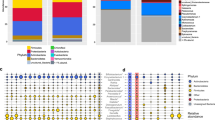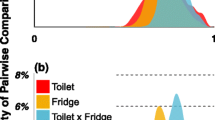Abstract
Archaea are widespread and abundant in soils, oceans, or human and animal gastrointestinal (GI) tracts. However, very little is known about the presence of Archaea in indoor environments and factors that can regulate their abundances. Using a quantitative PCR approach, and targeting the archaeal and bacterial 16S rRNA genes in floor dust samples, we found that Archaea are a common part of the indoor microbiota, 5.01 ± 0.14 (log 16S rRNA gene copies/g dust, mean ± SE) in bedrooms and 5.58 ± 0.13 in common rooms, such as living rooms. Their abundance, however, was lower than bacteria: 9.20 ± 0.32 and 9.17 ± 0.32 in bedrooms and common rooms, respectively. In addition, by measuring a broad array of environmental factors, we obtained preliminary insights into how the abundance of total archaeal 16S rRNA gene copies in indoor environment would be associated with building characteristics and occupants’ activities. Based on the results, Archaea are not equally distributed within houses, and the areas with greater input of outdoor microbiome and higher traffic and material heterogeneity tend to have a higher abundance of Archaea. Nevertheless, more research is needed to better understand causes and consequences of this microbial group in indoor environments.


Similar content being viewed by others
References
Woese CR, Kandler O, Wheelis ML (1990) Towards a natural system of organisms—proposal for the domains archaea, bacteria, and eucarya. Proc Natl Acad Sci U S A 87:4576–4579. doi:10.1073/pnas.87.12.4576
Schleper C, Jurgens G, Jonuscheit M (2005) Genomic studies of uncultivated archaea. Nat Rev Microbiol 3:479–488. doi:10.1038/nrmicro1159
Delong EF, Wu KY, Prezelin BB, Jovine RVM (1994) High abundance of archaea in antarctic marine picoplankton. Nature 371:695–697. doi:10.1038/371695a0
Timonen S, Bomberg M (2009) Archaea in dry soil environments. Phytochem Rev 8:505–518. doi:10.1007/s11101-009-9137-5
Bengtson P, Sterngren AE, Rousk J (2012) Archaeal abundance across a pH gradient in an arable soil and its relationship to bacterial and fungal growth rates. Appl Environ Microbiol 78:5906–5911. doi:10.1128/aem.01476-12
Lecours PB, Veillette M, Marsolais D, Duchaine C (2012) Characterization of bioaerosols from dairy barns: reconstructing the puzzle of occupational respiratory diseases by using molecular approaches. Appl Environ Microbiol 78:3242–3248. doi:10.1128/aem.07661-11
Just N, Lecours PB, Marcoux-Voiselle M, Kirychuk S, Veillette M, Singh B, Duchaine C (2013) Archaeal characterization of bioaerosols from cage-housed and floor-housed poultry operations. Can J Microbiol 59:46–50. doi:10.1139/cjm-2012-0305
Nehme B, Gilbert Y, Letourneau V, Forster RJ, Veillette M, Villemur R, Duchaine C (2009) Culture-independent characterization of archaeal biodiversity in swine confinement building bioaerosols. Appl Environ Microbiol 75:5445–5450. doi:10.1128/aem.00726-09
Rolleke S, Witte A, Wanner G, Lubitz W (1998) Medieval wall paintings - a habitat for archaea: identification of archaea by denaturing gradient gel electrophoresis (DGGE) of PCR-amplified gene fragments coding for 16S rRNA in a medieval wall painting. Int Biodeterioration Biodegradation 41:85–92. doi:10.1016/s0964-8305(98)80011-5
Rea S, Bowman JP, Popovski S, Pimm C, Wright ADG (2007) Methanobrevibacter millerae sp nov and Methanobrevibacter olleyae sp nov., methanogens from the ovine and bovine rumen that can utilize formate for growth. Int J Syst Evol Microbiol 57:450–456. doi:10.1099/ijs.0.63984-0
Miller TL, Lin CZ (2002) Description of Methanobrevibacter gottschalkii sp nov., Methanobrevibacter thaueri sp nov., Methanobrevibacter woesei sp nov and Methanobrevibacter wolinii sp nov. Int J Syst Evol Microbiol 52:819–822. doi:10.1099/ijs.0.02022-0
Sprenger WW, van Belzen MC, Rosenberg J, Hackstein JHP, Keltjens JT (2000) Methanomicrococcus blatticola gen. nov., sp nov., a methanol- and methylamine-reducing methanogen from the hindgut of the cockroach Periplaneta americana. Int J Syst Evol Microbiol 50:1989–1999
Jarvis GN, Strompl C, Burgess DM, Skillman LC, Moore ERB, Joblin KN (2000) Isolation and identification of ruminal methanogens from grazing cattle. Curr Microbiol 40:327–332. doi:10.1007/s002849910065
Dridi B, Fardeau ML, Ollivier B, Raoult D, Drancourt M (2012) Methanomassiliicoccus luminyensis gen. nov., sp nov., a methanogenic archaeon isolated from human faeces. Int J Syst Evol Microbiol 62:1902–1907. doi:10.1099/ijs.0.033712-0
Kulik EM, Sandmeier H, Hinni K, Meyer J (2001) Identification of archaeal rDNA from subgingival dental plaque by PCR amplification and sequence analysis. FEMS Microbiol Lett 196:129–133. doi:10.1016/s0378-1097(01)00051-9
Kembel SW, Jones E, Kline J, Northcutt D, Stenson J, Womack AM, Bohannan BJM, Brown GZ, Green JL (2012) Architectural design influences the diversity and structure of the built environment microbiome. ISME 6:1469–1479. doi:10.1038/ismej.2011.211
Rintala H, Pitkaeranta M, Toivola M, Paulin L, Nevalainen A (2008) Diversity and seasonal dynamics of bacterial community in indoor environment. BMC Microbiol 8:1–13, doi:10.1186/1471-2180-8-56
Rintala H, Pitkaranta M, Taubel M (2012) Microbial communities associated with house dust. In: Laskin AI, Sariaslani S, Gadd GM (eds) Advances in Applied Microbiology, vol 78., pp 75–120
Pitkaranta M, Meklin T, Hyvarinen A, Paulin L, Auvinen P, Nevalainen A, Rintala H (2008) Analysis of fungal flora in indoor dust by ribosomal DNA sequence analysis, quantitative PCR, and culture. Appl Environ Microbiol 74:233–244. doi:10.1128/aem.00692-07
Amend AS, Seifert KA, Samson R, Bruns TD (2010) Indoor fungal composition is geographically patterned and more diverse in temperate zones than in the tropics. Proc Natl Acad Sci U S A 107:13748–13753. doi:10.1073/pnas.1000454107
Flannigan B (2011) Microorganisms in indoor environment. In: Flannigan B, Samson RA, Miller D (eds) Microorganisms in home and indoor work environments: diversity, health impacts, investigation and control. CRC Press, Boca Raton
Kuhn DM, Ghannoum MA (2003) Indoor mold, toxigenic fungi, and Stachybotrys chartarum: Infectious disease perspective. Clin Microbiol Rev 16:144–172. doi:10.1128/cmr.16.1.144-172.2003
Li DW, Kendrick B (1995) Indoor aeromycota in relation to residential characteristics and allergic symptoms. Mycopathologia 131:149–157. doi:10.1007/bf01102894
Li DW, Kendrick B (1996) Functional and causal relationships between indoor and outdoor airborne fungi. Can J Bot-Revue Canadienne De Botanique 74:194–209
Mentese S, Arisoy M, Rad AY, Gullu G (2009) Bacteria and fungi levels in various indoor and outdoor environments in Ankara, Turkey. Clean-Soil Air Water 37:487–493. doi:10.1002/clen.200800220
Samson RA (2011) Ecology and general characteristics of indoor fungi. In: Olaf C, Adan G, Samson RA (eds) Fundamentals of mold growth in indoor environments and strategies for healthy living. Wageningen Academic Publishers, Netherland, pp 101–107
Pakarinen J, Hyvarinen A, Salkinoja-Salonen M, Laitinen S, Nevalainen A, Makela MJ, Haahtela T, von Hertzen L (2008) Predominance of Gram-positive bacteria in house dust in the low-allergy risk Russian Karelia. Environ Microbiol 10:3317–3325. doi:10.1111/j.1462-2920.2008.01723.x
Yuan I, Xu JR, Millar BC, Dooley JSG, Rooney PJ, Alexander HD, Moore JE (2007) Molecular identification of environmental bacteria in indoor air in the domestic home: description of a new species of Exiguobactetium. Int J Environ Health Res 17:75–82. doi:10.1080/09603120601124199
Kembel SW, Meadow JF, O’Connor TK, Mhuireach G, Northcutt D, Kline J, Moriyama M, Brown GZ, Bohannan BJM, Green JL (2014) Architectural design drives the biogeography of indoor bacterial communities. PLoS One 9:1–10. doi:10.1371/journal.pone.0087093
Meadow JF, Altrichter AE, Kembel SW, Kline J, Mhuireach G, Moriyama M, Northcutt D, O’Connor TK, Womack AM, Brown GZ, Green JL, Bohannan BJM (2014) Indoor airborne bacterial communities are influenced by ventilation, occupancy, and outdoor air source. Indoor Air 24:41–48. doi:10.1111/ina.12047
Adams RI, Miletto M, Taylor JW, Bruns TD (2013) Dispersal in microbes: fungi in indoor air are dominated by outdoor air and show dispersal limitation at short distances. ISME 7:1262–1273. doi:10.1038/ismej.2013.28
Sousa ACA, Almeida J, Pereira CC, Pastorinho MR, Pereira AMC, Nogueira AJA, Taborda-Barata L, Teixeira JP, Correia ACM, Alves A (2014) Characterization of fungal communities in house dust samples collected from central Portugal—a preliminary survey. J Toxicol Environ Health A 77:972–982. doi:10.1080/15287394.2014.911137
Subbarao P, Anand SS, Becker AB, Befus AD, Brauer M, Brook JR, Denburg JA, HayGlass KT, Kobor MS, Kollmann TR, Kozyrskyj AL, Lou WY, Mandhane PJ, Miller GE, Moraes TJ, Pare PD, Scott JA, Takaro TK, Turvey SE, Duncan JM, Lefebvre DL, Sears MR, CHILD Study Investigators (2015) The Canadian Healthy Infant Longitudinal Development (CHILD) Study: examining developmental origins of allergy and asthma. Thorax 70:998–1000. doi:10.1136/thoraxjnl-2015-207246
Takaro TK, Scott JA, Allen RW, Anand SS, Becker AB, Befus AD, Brauer M, Duncan J, Lefebvre DL, Lou W, Mandhane PJ, McLean KE, Miller G, Sbihi H, Shu H, Subbarao P, Turvey SE, Wheeler AJ, Zeng L, Sears MR, Brook JR, CHILD Study investigators (2015) The Canadian Healthy Infant Longitudinal Development (CHILD) birth cohort study: assessment of environmental exposures. J Expo Sci Environ Epidemiol 25:580–592. doi:10.1038/jes.2015.7
Pakpour S, Olishevska SV, Prasher SO, Milani AS, Chénier MR (2013) DNA extraction method selection for agricultural soil using TOPSIS multiple criteria decision-making model. Am J Mol Biol 3:215–228
Kemnitz D, Kolb S, Conrad R (2005) Phenotypic characterization of Rice Cluster III archaea without prior isolation by applying quantitative polymerase chain reaction to an enrichment culture. Environ Microbiol 7:553–565. doi:10.1111/j.1462-2920.2005.00723.x
Suzuki MT, Taylor LT, DeLong EF (2000) Quantitative analysis of small-subunit rRNA genes in mixed microbial populations via 5 ′-nuclease assays. Appl Environ Microbiol 66:4605–4614. doi:10.1128/aem.66.11.4605-4614.2000
Clarke KR, Gorley RN (2015) PRIMER v7: User Manual/Tutorial. PRIMER-E, Plymouth
StatSoft Inc. (2013) Electronic Statistics Textbook. StatSoft. WEB: http://www.statsoft.com/textbook/, Tulsa, OK.
Bintrim SB, Donohue TJ, Handelsman J, Roberts GP, Goodman RM (1997) Molecular phylogeny of archaea from soil. Proc Natl Acad Sci U S A 94:277–282. doi:10.1073/pnas.94.1.277
Buckley DH, Graber JR, Schmidt TM (1998) Phylogenetic analysis of nonthermophilic members of the kingdom Crenarchaeota and their diversity and abundance in soils. Appl Environ Microbiol 64:4333–4339
Ochsenreiter T, Selezi D, Quaiser A, Bonch-Osmolovskaya L, Schleper C (2003) Diversity and abundance of Crenarchaeota in terrestrial habitats studied by 16S RNA surveys and real time PCR. Environ Microbiol 5:787–797. doi:10.1046/j.1462-2920.2003.00476.x
Simon HM, Dodsworth JA, Goodman RM (2000) Crenarchaeota colonize terrestrial plant roots. Environ Microbiol 2:495–505. doi:10.1046/j.1462-2920.2000.00131.x
Saengkerdsub S, Ricke SC (2014) Ecology and characteristics of methanogenic Archaea in animals and humans. Crit Rev Microbiol 40:97–116. doi:10.3109/1040841x.2013.763220
Auguet JC, Barberan A, Casamayor EO (2010) Global ecological patterns in uncultured Archaea. ISME 4:182–190. doi:10.1038/ismej.2009.109
Bates ST, Berg-Lyons D, Caporaso JG, Walters WA, Knight R, Fierer N (2011) Examining the global distribution of dominant archaeal populations in soil. ISME 5:908–917. doi:10.1038/ismej.2010.171
Yin Q, Fu BB, Li BY, Shi XC, Inagaki F, Zhang XH (2013) Spatial variations in microbial community composition in surface seawater from the Ultra-Oligotrophic Center to rim of the South Pacific Gyre. PLoS One 8:1–12. doi:10.1371/journal.pone.0055148
Frohlich-Nowoisky J, Nespoli CR, Pickersgill DA, Galand PE, Muller-Germann I, Nunes T, Cardoso JG, Almeida SM, Pio C, Andreae MO, Conrad R, Poschl U, Despres VR (2014) Diversity and seasonal dynamics of airborne archaea. Biogeosciences 11:6067–6079. doi:10.5194/bg-11-6067-2014
Orell A, Frols S, Albers SV (2013) Archaeal biofilms: The great unexplored. Annu Rev Microbiol 67:337–354. doi:10.1146/annurev-micro-092412-155616
Frols S (2013) Archaeal biofilms: widespread and complex. Biochem Soc Trans 41:393–398. doi:10.1042/bst20120304
Acknowledgments
The authors are very grateful to all the families who participated in this study, and the whole miniCHILD study team, which included interviewers, laboratory technicians, research scientists, and volunteers. Useful discussions and valuable insight of Dr. Louise Nelson and Ms. Geet Hans from the University of British Columbia are greatly acknowledged. We also acknowledge the financial assistance from the Natural Sciences and Engineering Research Council of Canada (Discovery Grants) and the CHILD Study.
Author information
Authors and Affiliations
Corresponding author
Ethics declarations
Conflict of Interest
The authors declare no conflict of interest.
Rights and permissions
About this article
Cite this article
Pakpour, S., Scott, J.A., Turvey, S.E. et al. Presence of Archaea in the Indoor Environment and Their Relationships with Housing Characteristics. Microb Ecol 72, 305–312 (2016). https://doi.org/10.1007/s00248-016-0767-z
Received:
Accepted:
Published:
Issue Date:
DOI: https://doi.org/10.1007/s00248-016-0767-z




